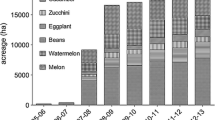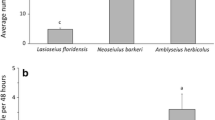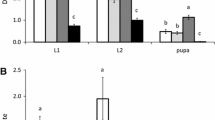Abstract
The establishment of biocontrol agents is critical for success of biological control strategies. Predator-in-First (PIF) is a prophylactic control strategy that aims to establish predators before the appearance of pests in an agro-ecosystem. PIF uses the ability of generalist phytoseiid mites to survive, develop and reproduce on pollen and thus establish in the absence of prey. The early establishment of populations of natural enemies helps control the pests at their incipient stage of infestation. The current study was undertaken to screen pepper cultivars for their ability to support populations of the predatory mite Amblyseius swirskii Athias–Henriot in the absence of prey. Twenty-nine pepper cultivars (11 hot and 18 sweet) were tested through a series of experiments, and four cultivars (7141, 992-7141, FPP7039 and FPP9048) were found to sustain A. swirskii populations throughout the study period. The initial application of pollen was important for establishment and maintenance of the predatory mites within the greenhouse system. Among the three screening experiments, high densities of mites were obtained in the experiment where 20 mites were released per plant, even reaching densities of >100 mites/plant. Recovery of predatory mites was significantly higher (ca. 2–3 fold) on the four pepper cultivars when predatory mites were mass released using an indirect method (banker plants) than when they were released directly on the seedlings, suggesting an advantage of passive continuous release. Future work will evaluate the selected pepper cultivars with the PIF strategy under greenhouse and field production conditions.



Similar content being viewed by others
References
Arthurs S, McKenzie C, Chen J, Dogramaci M, Brennan M, Houben K, Osborne L (2009) Evaluation of Neoseiulus cucumeris and Amblyseius swirskii (Acari: Phytoseiidae) as biological control agents of chilli thrips, Scirtothrips dorsalis (Thysanoptera: Thripidae) on pepper. Biol Control 49:91–96
Avery PB, Kumar V, Xiao YF, Powell CA, McKenzie CL, Osborne L (2014) Selecting an ornamental pepper banker plant for Amblyseius swirskii in floriculture crops. Arthropod Plant Interact 8:49–56
Bennison JA (1992) Biological control of aphids on cucumbers use of open rearing systems or ‘banker plants’ to aid establishment of Aphidius matricariae and Aphidoletes aphidimyza. Meded Fac Landbouwwet, Rijksuniv Gent 57:457–466
Calvo FJ, Bolckmans K, Belda JE (2011) Control of Bemisia tabaci and Frankliniella occidentalis in cucumber by Amblyseius swirskii. Biocontrol 56:185–192
Carrillo D, Peña JE, Hoy MA, Frank JH (2010) Development and reproduction of Amblyseius largoensis (Acari: Phytoseiidae) feeding on pollen, Raoiella indica (Acari: Tenuipalpidae), and other microarthropods inhabiting coconuts in Florida, USA. Exp Appl Acarol 52:119–129
Demirozer O, Tyler-Julian, K, Funderburk, J, Leppla, N, Reitz, S (2012) Frankliniella occidentalis (Pergande) integrated pest management programs for fruiting vegetables in Florida. Pest Manag Sci 68:1537–1545
Dogramaci M, Arthurs S, Chen J, Mckenzie CL, Irrizary F, Osborne LS (2011) Management of chilli thrips Scirtothrips dorsalis (Thysanoptera: Thripidae) on peppers by Amblyseius swirskii (Acari: Phytoseiidae) and Orius insidiosus (Hemiptera: Anthocoridae). Biol Control 59:340–347
Faraji F, Janssen A, Sabelis MW (2002) Oviposition patterns in a predatory mite reduce the risk of egg predation caused by prey. Ecol Entomol 27:660–664
FDACS (2000) The exotic invasion of Florida. A report on arthropod immigration into the sunshine state. Florida department of agriculture and consumer services. http://www.freshfromflorida.com/Divisions-Offices/Plant-Industry/Science/The-Exotic-Invasion-of-Florida
FDACS (2007) Florida Agricultural Statistical Directory. Florida Department of Agriculture and Consumer Services, Florida
Ferreira JAM, Eshuis B, Janssen A, Sabelis MW (2008) Domatia reduce larval cannibalism in predatory mites. Ecol Entomol 33:374–379
Ferreira JAM, Cunha DS, Pallini A, Sabelis MW, Janssen A (2011) Leaf domatia reduce intraguild predation among predatory mites. Ecol Entomol 36:435–441
Frank SD (2010) Biological control of arthropod pests using banker plants systems: past progress and future directions. Biol Control 52:8–16
Loughner R, Goldman, K, Loeb, G, Nyrop, J (2008) Influence of leaf trichomes on predatory mite (Typhlodromus pyri) abundance in grape varieties. Exp Appl Acarol 45:111–122
Gonzalez D, Wilson LT (1982) A food-web approach to economic thresholds: a sequence of pests/predaceous arthropods on California cotton. Entomophaga 27:31–43
Grostal P, O’Dowd DJ (1994) Plants, mites and mutualism: leaf domatia and the abundance and reproduction of mites on Viburnum tinus (Caprifoliaceae). Oecologia 97:308–315
Huang N, Enkegaard A, Osborne LS, Ramakers PMJ, Messelink GJ, Pijnakker J, Murphy G (2011) The banker plant method in biological control. Crit Rev Pla Sci 30:259–278
Kakkar G, Seal DR, Kumar V (2012) Assessing abundance and distribution of an invasive thrips Frankliniella schultzei (Trybom) (Thysanoptera: Thripidae) in South Florida. Bull Entomol Res 102:249–259
Kumar V, Kakkar G, Seal DR, McKenzie CL, Osborne L (2013) An overview of chilli thrips, Scirtothrips dorsalis (Thysanoptera: Thripidae) biology, distribution and management. In: Solenski S, Larramendy M (eds) Weed and pest control—conventional and new challenges. Intech, Rijeka, pp 53–77
Kumar V, Wekesa V, Avery PB, Powell CA, McKenzie CL, Osborne LS (2014a) Effect of pollens of various ornamental pepper cultivars on the development and reproduction of Amblyseius swirskii (Acari: Phytoseiidae). Fla Entomol 97:367–373
Kumar V, Kakkar G, Seal DR, McKenzie CL, Colee J, Osborne L (2014b) Temporal and spatial distribution of an invasive thrips species Scirtothrips dorsalis (Thysanoptera: Thripidae). Crop Prot 55:80–90
Kutuk H, Yigit A (2011) Pre-establishment of Amblyseius swirskii (Athias–Henriot) (Acari: Phytoseiidae) using Pinus brutia (Ten.) (Pinales: Pinaceae) pollen for thrips (Thysanoptera: Thripidae) control in greenhouse peppers. Intern J Acarol 37:95–101
Luckmann WH, Metcalf RL (1975) The pest-management concept. In: Metcalf RL, Luckmann WH (eds) Introduction to insect pest management. Wiley, New York, pp 3–35
McAvoy G, Ozores-Hampton M (2007) Common pepper cultivars for Florida production. University of Florida, IFAS extension publication #IPM204. http://edis.ifas.ufl.edu/in757. Accessed 15 July 2014
McKenzie CL, Kumar V, Palmer CL, Oetting RD, Osborne LS (2014) Chemical class rotations for control of Bemisia tabaci (Hemiptera: Aleyrodidae) on poinsettia and their effect on cryptic species population composition. Pest Manag Sci 70:1573–1587
McMurtry JA, Croft BA (1997) Life-styles of phytoseiid mites and their roles in biological control. Annu Rev Entomol 42:291–321
Messelink GJ, van Maanen R, van Steenpaal SEF, Janssen A (2008) Biological control of thrips and whiteflies by a shared predator: two pests are better than one. Biol Control 44:372–379
Nomikou M, Janssen A, Schraag R, Sabelis MW (2002) Phytoseiid predators suppress populations of Bemisia tabaci on cucumber plants with alternative food. Exp Appl Acarol 27:57–68
Nomikou M, Janssen A, Sabelis MW (2003) Phytoseiid predators of whiteflies feed and reproduce on non-prey food sources. Exp Appl Acarol 31:15–26
Nomikou M, Sabelis MW, Janssen A (2010) Pollen subsidies promote whitefly control through the numerical response of predatory mites. Biocontrol 55:253–260
Osborne LS, Barrett JE (2005) You can bank on it, banker plants can be used to rear natural enemies to help control greenhouse pests. Ornam Outlook, Sept, pp 26–27
Park HH, Shipp L, Buttenhuis R (2010) Predation, development, and oviposition by the predatory mite Amblyseius swirskii (Acari: Phytoseiidae) on tomato russet mite (Acari: Eriophyidae). J Econ Entomol 103:563–569
Parr WJ, Stacey DL (1976) ‘Banker’-plant system of whitefly parasite release on tomatoes. Rep Glasshouse Crops Res Inst 1975:96
Ragusa E, Tsolakis H, Palomero RJ (2009) Effect of pollens and preys on various biological parameters of the generalist mite Cydnodromus californicus. Bull Insectol 62:153–158
Ramakers PMJ (1990). Manipulation of phytoseiid thrips predators in the absence of thrips. IOBC/WPRS Bull 13:169–172
Ramakers PMJ (1995) Biological control using oligophagous predators. In: Parker BL, Skinner M, Lewis T (eds) Thrips biology and management. Plenum Press, New York, pp 225–229
Roda A, Nyrop J, Dicke M, English-Loeb G (2000) Trichomes and spider-mite webbing protect predatory mite eggs from intraguild predation. Oecologia 125:428–435
Romero GQ, Benson WW (2005) Biotic interactions of mites, plants and leaf domatia. Curr Opin Plant Biol 8:436–440
Sampson C (1998) The commercial development of an Amblyseius cucumeris controlled release method for the control of Frankliniella occidentalis in protected crops. In: Brighton crop protection conference: pests and diseases—1998. Proceedings of an international conference, vol 2. Brighton, UK, 16–19 Nov 1998, pp 409–416
SAS Institute (2009) JMP statistics and graphics guide version 8.0.1. SAS Institute, Cary
Seal DR, Kumar V, Kakkar G, Mello SC (2013) Abundance of adventive Thrips palmi (Thysanoptera: Thripidae) populations in Florida during the first sixteen years. Fla Entomol 96:789–796
Speyer ER (1927) An important parasite of the greenhouse whitefly. Bull Entomol Res 17:301–308
Stary P (1970) Biology of aphid parasites (Hymenoptera: Aphidiidae) with respect to integrated control. Series Entomololgica 6. Dr.W. Junk, The Hague, p 641
Stary P (1993) Alternative host and parasitoid in first method in aphid pest management in glasshouses. J Appl Entomol 116:187–191
van Rijn PCJ, van Houten YM, Sabelis MW (2002) How plants benefit from providing food to predators even when it is also edible to herbivores. Ecology 83:2664–2679
Wade MR, Zalucki MP, Wratten SD, Robinson KA (2008) Conservation biological control of arthropods using artificial food sprays: current status and future challenges. Biol Control 45:185–199
Walter DE (1996) Living on leaves: mites, tomenta, and leaf domatia. Annu Rev Entomol 41(297):101–114
Walter DE, O’Dowd DJ (1992) Leaves with domatia have more mites. Ecology 73:1514–1518
Xiao YF, Chen JJ, Cantliffe D, McKenzie CL, Houben K, Osborne L (2011a) Establishment of a papaya (Carica papaya L.) banker plant system for parasitoid, Encarsia sophia (Hymenoptera: Aphilidae) against Bemisia tabaci (Hemiptera: Aleyrodidae) in greenhouse tomato production. Biol Control 58:239–247
Xiao YF, Osborne L, Chen JJ, McKenzie CL, Houben K, Irizarry F (2011b) Evaluation of corn plant as potential banker plants for predatory gall midge, Feltiella acarisuga (Diptera: Cecidomyiidae) against Tetranychus urticae (Acari: Tetranychidae) in greenhouse vegetable crops. Crop Prot 36:1635–1642
Xiao YF, Avery PB, Chen JJ, McKenzie CL, Osborne L (2012) Ornamental pepper as banker plants for establishment of Amblyseius swirskii (Acari: Phytoseiidae) for biological control of multiple pests in greenhouse vegetable production. Biol Control 63:279–286
Acknowledgments
The authors would like to thank Katherine Houben, John Prokop, Irma Herrera, Fabieli Irizarry, and Younes Belmourd for their technical assistance. We would also like to thank Dr. James Colee for assisting in the statistical analysis and the internal reviewers Drs. Joseph Patt, J. Howard Frank and Aaron Dickey for their constructive criticism and helpful suggestions. Funding for this study was supported by Grants from the EPA, USDA/FDACS—Specialty Crop Block Grant Program, the USDA-ARS Floriculture and Nursery Research Initiative, and IFAS/UF Line Item grants program.
Author information
Authors and Affiliations
Corresponding author
Additional information
Vivek Kumar and Yingfang Xiao have contributed equally to this work.
Rights and permissions
About this article
Cite this article
Kumar, V., Xiao, Y., McKenzie, C.L. et al. Early establishment of the phytoseiid mite Amblyseius swirskii (Acari: Phytoseiidae) on pepper seedlings in a Predator-in-First approach. Exp Appl Acarol 65, 465–481 (2015). https://doi.org/10.1007/s10493-015-9895-2
Received:
Accepted:
Published:
Issue Date:
DOI: https://doi.org/10.1007/s10493-015-9895-2




